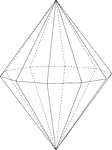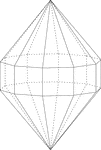Clipart tagged: ‘decagonal bipyramid’

Decagonal Bipyramid
Illustration of a decagonal bipyramid. A bipyramid, or dipyramid, is formed by joining two congruent…

Decagonal Bipyramid
Illustration of a decagonal bipyramid with hidden edges shown. A bipyramid, or dipyramid, is formed…

Elongated Decagonal Dipyramid
Illustration of an elongated decagonal dipyramid that is formed by elongating a decagonal bipyramid…

Elongated Decagonal Dipyramid
Illustration of an elongated decagonal dipyramid that is formed by elongating a decagonal bipyramid…

Elongated Decagonal Dipyramid
Illustration of an elongated decagonal dipyramid that is formed by elongating a decagonal bipyramid…